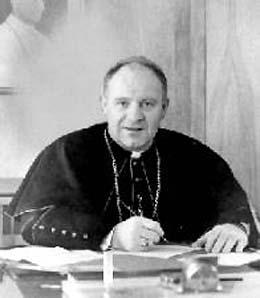On February 25, 1975, the Vatican names The Most Reverend Raymond G. Hunthausen (1921-2018) as the new archbishop of the Archdiocese of Seattle, replacing Archbishop Thomas Connolly (1899-1991), who is retiring due to age. Hunthausen attended the Secnd Vatican Council in 1962, and wholly embraces the changes it brought to the Catholic church. He ushers in a new era of modernity to the archdiocese, but also one of controversy, due to his liberal stance on social issues.
A Montana Bishop
When Archbishop Thomas Connolly hinted in 1974 that he would soon retire, many assumed that Bishop Raymond Hunthausen of Helena, Montana, would take his place. Hunthausen, who was then president of Carroll College in Helena, was considered to be hard-working, affable, and very experienced. Hunthausen entered the priesthood after graduating from Carroll College in 1943. He attended St. Edwards Seminary in Kenmore, and was ordained in 1947. He returned to Carroll College, where he became a chemistry professor, an athletic director, and then, in 1957, president.
In 1962, Hunthausen was appointed Bishop of Helena. Less than two months after his appointment, Pope John XXIII (1881-1963) convened the Second Vatican Council -- also known as Vatican II. Hunthuasen was the youngest American bishop to attend all four sessions, and decades later, he became the last surviving American bishop who had attended Vatican II.
The Second Vatican Council brought sweeping change to the Catholic Church and its relationship with the modern world. Vatican II was the first ecumenical council in nearly 100 years, and the most radically reformative since the Reformation of the sixteenth century. The council sought to build bridges between the church and others faiths, empowered the laity to help define Catholic morals, and permitted languages other than Latin to be used during Mass. Some Catholic traditionalists bristled at these transformations, but Hunthausen embraced the teachings of Vatican II, noting that the church had become "overly reliant on the power of law and discipline." Hunthausen later stated that "the council and the Gospels tell each one of us to be responsible, to discern as we can in the spirit of love just what God is asking us to do" (Seattle Weekly, December 21, 1983).
For the People
In 1974, when Archbishop Connolly announced plans to retire in Seattle, the church polled members of the diocese, asking them what attributes they'd most like to see in a new archbishop. Whereas Connolly was considered by many to be administrative and authoritarian, the clergy and laity wanted someone who was more approachable. Hunthausen's pastoral -- rather than doctrinal -- nature, as well as his democratic management style, was just the sort of archbishop they were looking for.
On February 25, 1975, the Vatican accepted the resignation of Archbishop Connolly and named Hunthausen as his successor. He was formally installed at the Seattle Center Arena on May 22, by the Most Reverend Jean Jadot (1909-2009), apostolic delegate of Pope Paul VI (1897-1978). The ceremony was originally planned for St. James Cathedral, but was moved to Seattle Center so that more people could attend. The audience included more than 400 priests, 10 bishops and archbishops, three abbots, and 6,000 members of the laity.
Once installed, Archbishop Hunthausen immediately made plans to say mass at a different parish in the diocese each Sunday of the year. Hunthausen spent countless hours traveling around Western Washington to meet with members of his flock and with the clergy. Dressed informally, without sashes or skullcaps, he was considered by almost everybody he met as warm and personable -- unlike any other archbishop they had ever seen or heard about.
Controversy
Archbishop Hunthausen was well loved by many in the diocese, but because of his stance on certain social issues, he also had his detractors. He was outspoken against the Vietnam War, and at one point withheld half of his federal taxes to protest the stockpiling of nuclear weapons. He also attended peaceful protests at the nuclear submarine base at Bangor.
Perhaps his most controversial stance, and one that drew the most ire from Catholics, was his stance on gay rights. In 1977, he issued a letter publicly defending the rights of gays and lesbians, and later permitted a gay-lesbian Catholic group to have a mass at St. James Cathedral.
Ultimately, the Vatican undertook an extensive investigation of Hunthausen, led by Joseph Cardinal Ratzinger (1927-2022) who later became Pope Benedict XVI. Hunthausen was stripped of some of his authority, and a new auxiliary bishop was appointed. Hunthausen fought back, and the auxiliary bishop was later reassigned. Nevertheless, a three-cardinal team continued to oversee the diocese until 1989, and Hunthausen retired in 1991. He moved back to Montana, where he enjoyed hiking and fishing. Over the years he made several visits back to Seattle.

